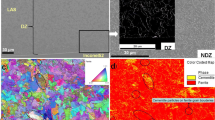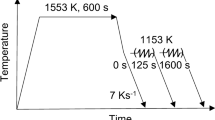Abstract
The complex microstructures developed during post-welding heat-treatment in the vicinity of the fusion line between a ferritic and austenitic steel were examined in the case of submerged arc welded 18MND5/309L dissimilar joints. Quantitative measurements of the carbon distribution in the as-welded and post-weld heat-treated conditions were performed by both wavelength dispersive spectrometry and secondary ion mass spectrometry. The extent of carbon diffusion was confirmed by hardness profiles performed by nanoindentation. On the low-alloy ferritic side, decarburization resulted in cementite dissolution allowing the evolution of the bainitic structure toward a large-grained ferritic region. In the weld metal, the carbon content reached unusually high levels and an intense precipitation of chromium-rich carbides was observed in both the interfacial martensitic layer and the austenitic weld metal. The evolution of the precipitation as a function of the distance from the interface was analyzed in terms of crystallography, chemistry, volume fractions, and size distributions. Automated crystal orientation mapping in a transmission electron microscope allowed identification of the precipitates extracted on carbon replicas from both the martensitic and austenitic matrices. A 3D reconstruction of the carbides population in the martensitic layer was performed by serial cutting with a focused ion beam: M 7 C 3 and M 23 C 6 were found to coexist in the two carburized regions, but displayed different sizes, compositions, and morphologies, depending on their location with respect to the fusion line. This evolution in terms of precipitation was analyzed taking into account the local microstructure and composition.
















Similar content being viewed by others
Notes
In what follows, we will continue designating as martensite the intermediate layer with a lathy microstructure, even if it has been tempered during the welding of the second cladding layer and the subsequent post-weld heat-treatment.
Estimated by Monte-Carlo simulations for a 16 kV electron beam on an iron sample.
Value extracted from the mc-fe.ddb database of the MatCalc software [41]
References
Sopoušek J, Foret R, Jan V (2004) Simulation of dissimilar weld joints of steel P91. Sci Technol Weld Join 9(1):59–64
Race JM, Bhadeshia H (1993) Carbon migration across dissimilar steel welds. Int Trends Weld Sci Technol 1–5
Gómez X, Echeberría J (2000) Microstructure and mechanical properties of low alloy steel T11–austenitic stainless steel 347H bimetallic tubes. Mater Sci Technol 16(2):187–193
Silva CC, Miranda HC, de Sant’Ana HB, Farias JP (2013) Austenitic and ferritic stainless steel dissimilar weld metal evaluation for the applications as-coating in the petroleum processing equipment. Mater Des 47:1–8
Foret R, Zlamal B, Sopousek J (2006) Structural stability of dissimilar weld between two Cr-Mo-V steels. Weld J 85:211s–217s
Darken LS (1949) Diffusion of carbon in austenite with a discontinuity in composition. Trans AIME 180(430–438):53
Christoffel RJ, Curran RM (1956) Carbon migration in welded joints at elevated temperatures. Weld J 35:457s–465s
Race JM, Bhadeshia HKDH (1992) Precipitation sequences during carburisation of Cr–Mo steel. Mater Sci Technol 8(10):875–882
Kozeschnik E, Pölt P, Brett S, Buchmayr B (2002) Dissimilar 2·25Cr/9Cr and 2Cr/0·5CrMoV steel welds: part 1: characterisation of weld zone and numerical simulation. Sci Technol Weld Join 7(2):63–68
Huang ML, Wang DL (1998) Carbon migration in 5Cr-0.5 Mo/21Cr-12Ni dissimilar metal welds. Metall Mater Trans A 29(12):3037–3046
Albert SK, Gill TPS, Tyagi AK, Mannan SL, Kulkarni SD, Rodriguez P (1997) Soft zone formation in dissimilar welds between two Cr-Mo steels. Weld J Weld Res Suppl 76(3):135–142
Kozeschnik E, Warbichler P, Letofsky-Papst I, Brett S, Buchmayr B (2002) Dissimilar 2·25Cr/9Cr and 2Cr/0·5CrMoV steel welds: part 2: identification of precipitates. Sci Technol Weld Join 7(2):69–76
Lundin CD (1982) Dissimilar metal welds-transition joints literature review. Weld J 61(2):58–63
Gauzzi F, Missori S (1988) Microstructural transformations in austenitic-ferritic transition joints. J Mater Sci 23(3):782–789. doi:10.1007/BF01153967
He K, Brown A, Brydson R, Edmonds DV (2006) Analytical electron microscope study of the dissolution of the Fe3C iron carbide phase (cementite) during a graphitisation anneal of carbon steel. J Mater Sci 41(16):5235–5241. doi:10.1007/s10853-006-0588-4
Scott CP, Drillet J (2007) A study of the carbon distribution in retained austenite. Scr Mater 56(6):489–492
Valle N, Drillet J, Bouaziz O, Migeon H-N (2006) Study of the carbon distribution in multi-phase steels using the NanoSIMS 50. Appl Surf Sci 252(19):7051–7053
Laigo J, Christien F, Le Gall R, Tancret F, Furtado J (2008) SEM, EDS, EPMA-WDS and EBSD characterization of carbides in HP type heat resistant alloys. Mater Charact 59(11):1580–1586
Lan L, Qiu C, Zhao D, Gao X, Du L (2012) Analysis of martensite–austenite constituent and its effect on toughness in submerged arc welded joint of low carbon bainitic steel. J Mater Sci 47(11):4732–4742. doi:10.1007/s10853-012-6346-x
Li YJ, Choi P, Borchers C, Chen YZ, Goto S, Raabe D, Kirchheim R (2011) Atom probe tomography characterization of heavily cold drawn pearlitic steel wire. Ultramicroscopy 111(6):628–632
Garcia-Mateo C, Caballero FG, Miller MK, Jimenez JA (2011) On measurement of carbon content in retained austenite in a nanostructured bainitic steel. J Mater Sci 47(2):1004–1010. doi:10.1007/s10853-011-5880-2
Seidel F, Stock H-R, Mayr P (1997) Glow discharge optical spectroscopy depth profiles of ion implanted steel, titanium and titanium nitride coatings. Thin Solid Films 308:425–429
Mändl S, Fritzsche B, Manova D, Hirsch D, Neumann H, Richter E, Rauschenbach B (2005) Wear reduction in AISI 630 martensitic stainless steel after energetic nitrogen ion implantation. Surf Coat Technol 195(2):258–263
Helander T, Ågren J (1997) Computer simulation of multicomponent diffusion in joints of dissimilar steels. Metall Mater Trans A 28(2):303–308
Larsson H, Engström A (2006) A homogenization approach to diffusion simulations applied to α + γ Fe–Cr–Ni diffusion couples. Acta Mater 54(9):2431–2439
Pan C, Wang R, Gui J, Shi Y (1990) Direct TEM observation of microstructures of the austenitic/carbon steels welded joint. J Mater Sci 25(7):3281–3285. doi:10.1007/BF00587687
Ishida T (1991) Formation of stainless steel layer on mild steel by welding arc cladding. J Mater Sci 26(23):6431–6435. doi:10.1007/BF02387825
Nelson TW, Lippold JC, Mills MJ (2000) Nature and evolution of the fusion boundary in ferritic-austenitic dissimilar metal welds. Part 2-On-cooling transformations. Weld Res 79:267s–277s
Wu Y, Patchett BM (1992) Formation of crack-susceptible structures of weld overlay of corrosion resistant alloys. Mater Perform Sulphur Energy 283–295
Iso 16592 Analyse par microfaisceaux—analyse par microsonde électronique (microsonde de Castaing)—lignes directrices pour le dosage du carbone dans les aciers par la droite d’étalonnage
Oliver WC, Pharr GM (1992) An improved technique for determining hardness and elastic modulus using load and displacement sensing indentation experiments. J Mater Res 7(6):1564–1583
Gatan ion beam etching in Material Characterization, Final report Isolde Gräf, TU Darmstadt in cooperation with Gatan GmbH, Münich
Rauch EF, Duft A (2005) Orientation maps derived from TEM diffraction patterns collected with an external CCD camera. Mater Sci Forum 495–497:197–202
Rauch EF, Véron M, Nicolopoulos S, Bultreys D (2012) Orientation and phase mapping in TEM microscopy (EBSD-TEM like): applications to materials science. Solid State Phenom 186:13–15
Oliver WC, Pharr GM (2004) Measurement of hardness and elastic modulus by instrumented indentation: advances in understanding and refinements to methodology. J Mater Res 19(01):3–20
Moeck P, Rouvimov S, Rauch EF, Veron M, Kirmse H, Häusler I, Neumann W, Bultreys D, Maniette Y, Nicolopoulos S (2011) High spatial resolution semi-automatic crystallite orientation and phase mapping of nanocrystals in transmission electron microscopes. Cryst Res Technol 46(6):589–606
Shtansky DV, Nakai K, Ohmori Y (2000) Decomposition of martensite by discontinuous-like precipitation reaction in an Fe–17Cr–0.5C alloy. Acta Mater 48(4):969–983
Berkane R, Gachon JC, Charles J, Hertz J (1987) A thermodynamic study of the chromium-carbon system. CALPHAD 11(4):375–382
Shtansky DV, Nakai K, Ohmori Y (1999) Crystallography and interface boundary structure of pearlite with M 7 C 3 carbide lamellae. Acta Mater 47(4):1105–1115
Kozeschnik E, Buchmayr B (1999) MATCALC—a simulation tool for multicomponent thermodynamics, diffusion and phase transformations. In Fifth international seminar on the numerical analysis of weldability. pp. 349–361
Van Landeghem HP, Gouné M, Redjaïmia A (2012) Nitride precipitation in compositionally heterogeneous alloys: nucleation, growth and coarsening during nitriding. J Cryst Growth 341(1):53–60
Villars P, Cenzual K (2010) Pearson’s crystal data: crystal structure database for inorganic compounds. ASM International, Materials Park
Acknowledgement
This study was sponsored by both EDF and AREVA through a PhD Grant (FM). In addition, the authors wish to thank M. Verdier (SIMaP) for nanoindentation scans, M. Véron (SIMaP) for her assistance in operating Astar software, P. Perrenot (SIMaP) for his help in the FIB data analysis, B. El Adib (CRP-GL) for the valued contribution to SIMS measurements, and E. Kozeschnik (TU Wien) for enabling thermodynamics calculations with the MatCalc software.
Author information
Authors and Affiliations
Corresponding author
Ethics declarations
Conflict of interest
This study was funded by EDF R&D and AREVA. F. Mas has received a research Grant from AREVA. The authors declare that they have no conflict of interest.
Rights and permissions
About this article
Cite this article
Mas, F., Tassin, C., Valle, N. et al. Metallurgical characterization of coupled carbon diffusion and precipitation in dissimilar steel welds. J Mater Sci 51, 4864–4879 (2016). https://doi.org/10.1007/s10853-016-9792-z
Received:
Accepted:
Published:
Issue Date:
DOI: https://doi.org/10.1007/s10853-016-9792-z




